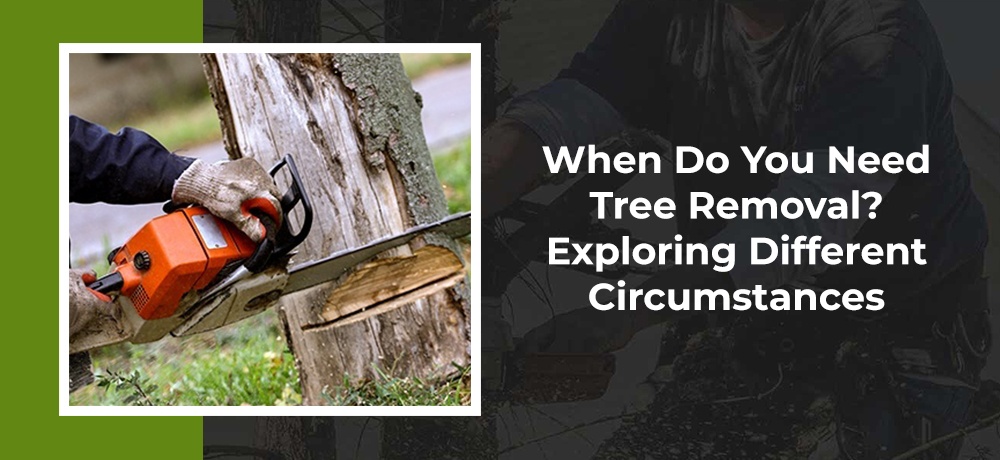When Do You Need Tree Removal? Exploring Different Circumstances

Picture this: you're strolling through your backyard, admiring the beauty of nature, when suddenly, you notice a towering tree that seems to have seen better days. Its branches are brittle, leaves are sparse, and you can't help but wonder, is it time for tree removal? Trees are magnificent creatures that provide shade and oxygen and enhance the aesthetics of our surroundings. However, there are instances when removing a tree becomes necessary. In this blog, Any Height Tree Services will delve into different circumstances that warrant tree removal and shed light on when it becomes crucial to take action.
1. Safety Hazards: Protecting Life and Property
When trees begin to pose safety risks, removal becomes paramount. Whether due to disease, pest infestation, or structural issues, a compromised tree can become a potential threat. Consider the following scenarios:
a) Disease and Decay: Trees afflicted by diseases or decay can become weak, making them prone to falling during strong winds or storms. If a tree displays signs of extensive rot or has hollow areas in its trunk, it may be at risk of toppling over unexpectedly.
b) Damaged or Hanging Limbs: Storms can cause branches to break or hang precariously. These damaged limbs can pose a threat to people, vehicles, or structures below. If a tree exhibits significant limb damage, it may be necessary to remove it to ensure the safety of your surroundings.
c) Leaning Trees: Trees leaning at an extreme angle can be a cause for concern. A leaning tree indicates structural instability and may indicate root problems or soil issues. In such cases, removing the tree is crucial to prevent it from falling unpredictably.
2. Diseased Trees: Preserving the Health of Your Landscape
Trees, like any living organism, are susceptible to diseases that can spread and potentially harm nearby plants and vegetation. When a tree becomes severely diseased, removal may be the best course of action to protect the overall health of your landscape. Look out for the following signs:
a) Fungal Growth: If you notice mushroom-like growths or fungal brackets on the trunk or around the base of a tree, it may indicate a serious underlying issue. Fungal infections can weaken the tree's structure and make it more susceptible to breakage.
b) Bark Damage and Cankers: Damage to a tree's bark, such as cracks, wounds, or cankers, can provide entry points for pests and pathogens. If left untreated, these issues can lead to irreversible damage and may necessitate tree removal.
c) Widespread Pest Infestation: Pests like beetles or borers can invade trees, causing extensive damage to the tree's vascular system. When a tree's health is severely compromised due to infestation, removal may be the only option to prevent the spread of pests to other nearby trees.
3. Landscaping and Construction Projects: Clearing the Way
While trees contribute to the natural beauty of our surroundings, there are times when their removal becomes necessary for landscaping or construction purposes. Consider the following scenarios:
a) Overcrowding: When trees are planted too close together, they compete for resources such as sunlight, water, and nutrients. This can lead to stunted growth and diminished health. In some cases, removing one or more trees can help improve the overall health and vitality of the remaining trees.
b) Space Constraints: If you're planning a construction project or adding an extension to your home, the presence of a tree in the designated area may hinder the process. In such situations, removal might be required to make room for the intended development while maintaining structural integrity.
c) Tree Species Incompatibility: Certain tree species, when planted in proximity to each other, can cause issues due to incompatible growth patterns or root systems. In such cases, removing one or more trees of incompatible species may be necessary to ensure the healthy development of the remaining vegetation.
Knowing when tree removal is required is crucial for maintaining the safety, health, and aesthetics of your landscape. Whether it's addressing safety hazards, preserving the overall health of your trees, or making room for landscaping or construction projects, there are various circumstances that warrant the removal of a tree. However, tree removal should always be approached with careful consideration and expertise.
If you find yourself facing any of the situations discussed in this blog, reach out to us at Any Height Tree Services. As professionals, we ensure that we exceed expectations and always put you first. We offer services like tree removal services, tree pruning, tree stump grinding, arborist reports and consulting, hedge trimming, wood chip and wood delivery, tree bracing and cabling, tree pests, and disease management to clients across North York, Toronto, Thornhill, Vaughan, Richmond, and the Greater Toronto Area.
Get in touch with us today!
To learn more about the services we offer, please click here. If you have any questions about how we can help you, get in touch with us by clicking here.